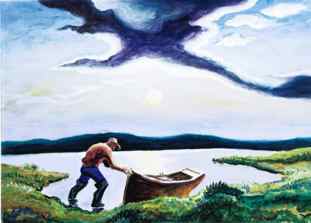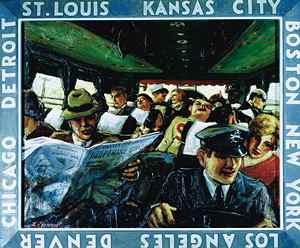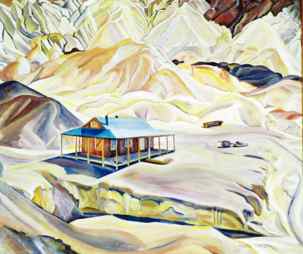Editor's note: The Frist Center for the Visual
Arts provided source material to Resource Library Magazine for
the following article or essay. If you have questions or comments regarding
the source material, please contact the Frist Center for the Visual Arts
directly through either this phone number or web address:
Coming Home: American Paintings,
19301950, from the Schoen Collection
June 4 - September 6, 2004
The paintings in Coming
Home: American Paintings, 19301950, from the Schoen Collection depict
the  sweeping social, artistic,
and political transformations that took place during two of the most critical
decades in American history. Featuring approximately 60 paintings, Coming
Home includes works by such acclaimed painters as Regionalists Thomas
Hart Benton and John Steuart Curry; Magic Realist Paul Cadmus; Surrealist
Federico Castellon; and Social Realists Ben Shahn and Raphael Soyer. The
time period of the exhibition extends from the Wall Street Crash of 1929
and proceeds through the years of the Great Depression, concluding with
images showing the impact of World War II on the home front. (right:
Thomas Hart Benton, Fisherman at Sunset, 1947, gouache on
paper, 15 x 21 inches)
sweeping social, artistic,
and political transformations that took place during two of the most critical
decades in American history. Featuring approximately 60 paintings, Coming
Home includes works by such acclaimed painters as Regionalists Thomas
Hart Benton and John Steuart Curry; Magic Realist Paul Cadmus; Surrealist
Federico Castellon; and Social Realists Ben Shahn and Raphael Soyer. The
time period of the exhibition extends from the Wall Street Crash of 1929
and proceeds through the years of the Great Depression, concluding with
images showing the impact of World War II on the home front. (right:
Thomas Hart Benton, Fisherman at Sunset, 1947, gouache on
paper, 15 x 21 inches)
During the 1930s and 1940s, many artists turned to subject
matter that reflected their experiences of the locales in which they lived
and worked. Known as Regionalism or American Scene painting, this trend
emerged in all corners of the country, as artists told visual stories about
the people in towns, cities, and the countryside who enacted their quotidian
lives with heroism, humor, or tenacity in the face of economic hardships.
These artists were often supported by such programs as
the Works Progress Administration (WPA) and its division, the Federal Arts
Project (FAP); the Farm Security Administration (FSA); and the Treasury
Department's Section of Fine Arts (SFA). Throughout the 1930s, these New
Deal agencies encouraged artists to document the American experience. Many
who took part in Federal art programs sought to capture the distinctive
characteristics of the country's regions and its people, in ways that could
be understood by everyone who saw them. Even artists who received no government
support often embraced the idea of an art that would speak directly of people's
own lives.
The first two galleries in the exhibition are arranged
to represent a visual trip across America. It begins with scenes  of New York by Isaac Soyer, Joseph Hirsch, and Eugenie
MacEvoy, and then continues with depictions of steamy Southern nights by
Charles Shannon and William Hollingsworth; Midwestern farms and farmers
by Guy MacCoy and John Steuart Curry; and people living and working in the
inhospitable environments of Western deserts and mountains, as shown in
paintings by Peter Hurd and Alfredo Ramos Martinez. (right: Louis
Freund, Transcontinental Bus, 1936, oil on panel, 25 x 31 inches)
of New York by Isaac Soyer, Joseph Hirsch, and Eugenie
MacEvoy, and then continues with depictions of steamy Southern nights by
Charles Shannon and William Hollingsworth; Midwestern farms and farmers
by Guy MacCoy and John Steuart Curry; and people living and working in the
inhospitable environments of Western deserts and mountains, as shown in
paintings by Peter Hurd and Alfredo Ramos Martinez. (right: Louis
Freund, Transcontinental Bus, 1936, oil on panel, 25 x 31 inches)
While the Regionalists sought a distinctively American
style and subject matter, artists in the third gallery reflected developments
in art beyond the nation's borders. For them, it was less important to convey
their experience of their immediate environments than to create beauty or
convey a sense of fantasy or mystery. Jessie Arms Botke's exquisite Flamingoes
and Lotus (ca. 1939) recalls the influence of Japanese art popular in
late nineteenth-century and early twentieth-century decorative arts. Painted
with equal clarity and grace, the Magic Realist artist Paul Cadmus's Shells
and Figure (1940) combines a love for the fantastic with a stylistic
precision that makes the work seem to have been painted from direct observation.
Helen Lundeberg's Poetic Justice (1945) similarly combines
the meticulous technique of Northern Renaissance artists with the dream
imagery of European Surrealism. Although not prominently featured in the
Schoen collection, many of the artists in this section helped pave the way
for the generation of Abstract Expressionists that came in the 1940s, who
were inspired by the Surrealist goal of giving aesthetic form to the unconscious
realm.
The last section of Coming Home is dedicated to
works that document the Great Depression and the homefront during World
War II. In 1931, a severe and long-lasting drought hit Midwestern and Western
states, further intensifying the devastation of the nation's economy incurred
by the Wall Street crash of 1929. Millions of Americans suffered unemployment,
poverty and the loss of their homes during these years. In the Dust Bowl,
crops were destroyed as blinding dust storms swept across the panhandles
of Texas and Oklahoma, western Kansas, and the eastern portions of Colorado
and New Mexico. Many people abandoned their farms and traveled the country
in search of agricultural work, as dramatized in the classic novel The
Grapes of Wrath. Like author John Steinbeck, artists William Gropper
in The Last Cow (1937), Mervin Jules in Bare Statement (1941),
and John Langley Howard in Hooverville (1933) focused attention on
the plight of these displaced people through powerful narrative scenes,
many of which they had observed firsthand as they traveled through the region.
Other artists, angered by the government's slowness in
alleviating the suffering of the homeless and jobless, and by the often
brutal tactics of local authorities in their treatment of dispossessed people,
were moved to a more activist stance with their paintings. Often members
of the political left, Social Realists like Ben Shahn in Unemployed (1938),
Henry Billings in The Arrest No. 2 (1936), and William Gropper in
The Incumbent (ca. 1938) used their art to expose these injustices,
which they believed were contrary to the egalitarian spirit of democracy.

When the nation entered World War II, millions of its citizens
found jobs in the defense industry, reducing unemployment and helping to
revive the economy. Artists were among the sixteen million Americans who
joined the armed forces, often serving as war reporters and correspondents.
Those who stayed behind frequently portrayed their countrymen supporting
the war effort through factory and farm work. Clarence Holbrook Carter's
Good Crop and Isaac Soyer's Defense Plant Worker (both 1942)
conclude the exhibition with symbols of strength and hope that portend a
new beginning for the nation. (right: Helen Forbes, Mountains
and Miner's Shack, 1940, oil on canvas, 34 x 40 inchcs)
As the economy improved, federal relief and patronage were
phased out, and artists who had participated in New Deal art programs returned
to the private sector or began teaching in colleges and universities across
the country. Many of their students were veterans benefiting from a new
government program, the G.I. Bill of 1944, which made higher education available
to the men and women who had served in the military.
ABOUT THE COLLECTOR
Jason Schoen has vigorously pursued his passion for collecting
American art of the 1930s and 1940s for more than 20 years. While he has
acquired important examples of Social Realism, abstraction, and Surrealism,
Schoen has been most interested in having his collection foster an understanding
of the regionalist impulse that appeared in much of the period's art. "A
goal of mine," he writes," has been to create a collection of
regional art, which can serve as a study collection and an introduction
to an era, as a slice of life and a window onto an important period in American
history."
Editor's note: RLM readers may also enjoy:
Please Note: TFAOI and RLM
do not endorse sites behind external links.
Read more articles and essays concerning this institutional
source by visiting the sub-index page for the Frist
Center for the Visual Arts in Resource
Library Magazine.
Visit the Table
of Contents for Resource Library Magazine for
thousands of articles and essays on American art, calendars, and much more.
Copyright 2003, 2004 Traditional Fine Arts Organization, Inc., an Arizona nonprofit corporation. All rights
reserved.
 sweeping social, artistic,
and political transformations that took place during two of the most critical
decades in American history. Featuring approximately 60 paintings, Coming
Home includes works by such acclaimed painters as Regionalists Thomas
Hart Benton and John Steuart Curry; Magic Realist Paul Cadmus; Surrealist
Federico Castellon; and Social Realists Ben Shahn and Raphael Soyer. The
time period of the exhibition extends from the Wall Street Crash of 1929
and proceeds through the years of the Great Depression, concluding with
images showing the impact of World War II on the home front. (right:
Thomas Hart Benton, Fisherman at Sunset, 1947, gouache on
paper, 15 x 21 inches)
sweeping social, artistic,
and political transformations that took place during two of the most critical
decades in American history. Featuring approximately 60 paintings, Coming
Home includes works by such acclaimed painters as Regionalists Thomas
Hart Benton and John Steuart Curry; Magic Realist Paul Cadmus; Surrealist
Federico Castellon; and Social Realists Ben Shahn and Raphael Soyer. The
time period of the exhibition extends from the Wall Street Crash of 1929
and proceeds through the years of the Great Depression, concluding with
images showing the impact of World War II on the home front. (right:
Thomas Hart Benton, Fisherman at Sunset, 1947, gouache on
paper, 15 x 21 inches) of New York by Isaac Soyer, Joseph Hirsch, and Eugenie
MacEvoy, and then continues with depictions of steamy Southern nights by
Charles Shannon and William Hollingsworth; Midwestern farms and farmers
by Guy MacCoy and John Steuart Curry; and people living and working in the
inhospitable environments of Western deserts and mountains, as shown in
paintings by Peter Hurd and Alfredo Ramos Martinez. (right: Louis
Freund, Transcontinental Bus, 1936, oil on panel, 25 x 31 inches)
of New York by Isaac Soyer, Joseph Hirsch, and Eugenie
MacEvoy, and then continues with depictions of steamy Southern nights by
Charles Shannon and William Hollingsworth; Midwestern farms and farmers
by Guy MacCoy and John Steuart Curry; and people living and working in the
inhospitable environments of Western deserts and mountains, as shown in
paintings by Peter Hurd and Alfredo Ramos Martinez. (right: Louis
Freund, Transcontinental Bus, 1936, oil on panel, 25 x 31 inches)